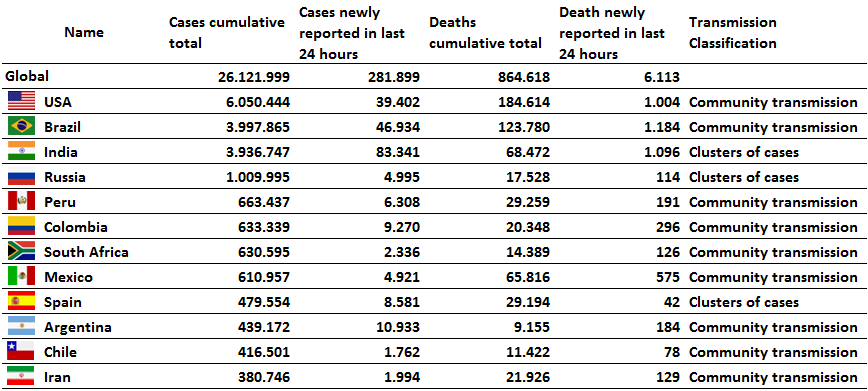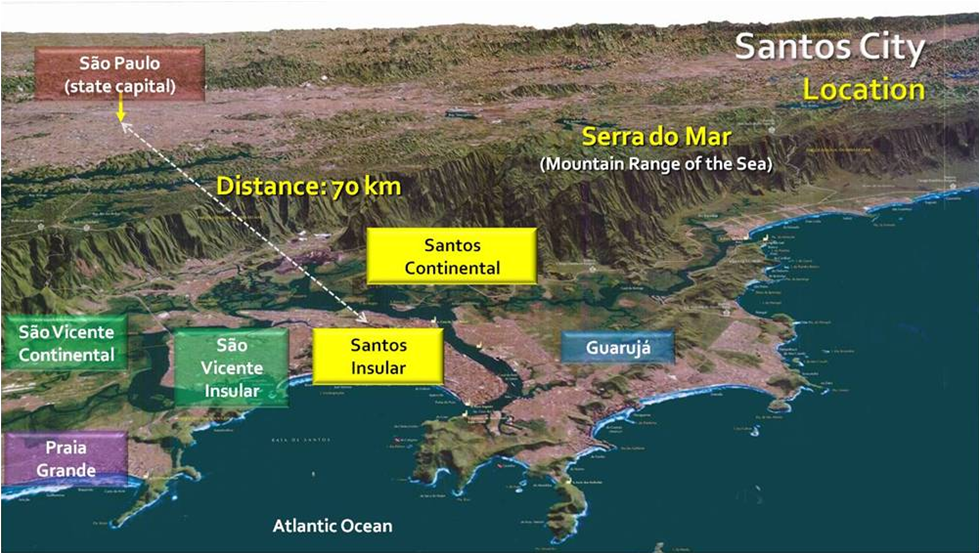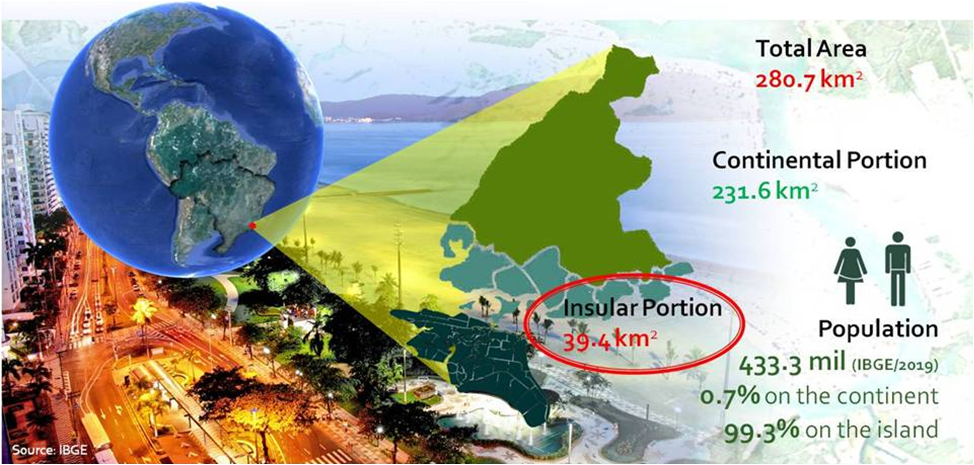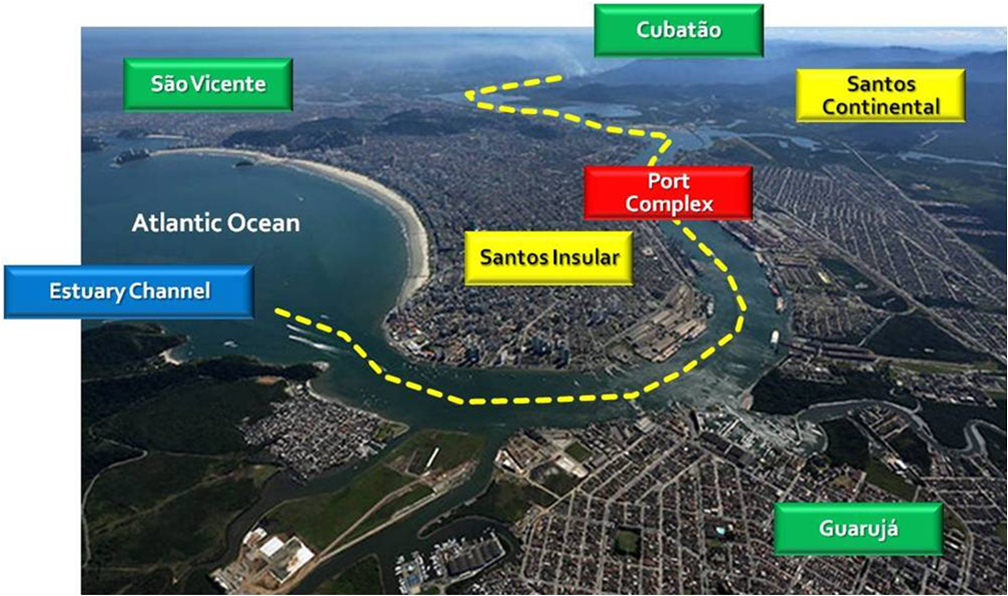According to the WHO Coronavirus Disease (COVID-19) Dashboard, updated on September 4, 2020, the world had 26,121,999 confirmed cases, and 864,618 deaths. The following table shows the situation by country.
Situation by Country, Territory & Area, partial adapted by the Author. (WHO Coronavius Disease (COVID-19) Dashboard. World Health Organization. (Available on: https://covid19.who.int/table. Web. 4 September 2020).
Worldometers [1] presents, considering the same reference date, a list of countries based on the United Nations Geoscheme, in which it is possible to identify the COVID-19 lethality index by country. Brazil, second in total accumulated deaths, appears in ninth place, in terms of deaths per million inhabitants, behind San Marino, Peru, Belgium, Andorra, Spain, United Kingdom, Chile and Italy, nearly followed by Sweden and the United States.
The city of Santos
Santos is located in the state of São Paulo and is a central city in a metropolitan region made up of nine municipalities, with a total of almost 2 million inhabitants. Its location is presented in the following image.
The city of Santos location. (Source: Santos City Hall, adapted by the Author).
Today Santos has approximately 433.3 thousand inhabitants, being that 99.3% of its population is concentrated in the portion of the island, which results in a high demographic density. Santos is considered the most verticalized city in the country. The following image shows a summary of information about the city.
The city of Santos. (Source: Santos City Hall and IBGE, adapted by the Author).
Due to its infrastructure and quality of life, Santos was one of the cities that received the most metropolitan travels before the COVID-19 pandemic.
In September 2020, although the city is in an accelerated process of resuming its daily activities, commercial, academic, labor, tourist and cultural flows still remain significantly affected, locally and regionally.
Santos is a metropolitan reference center in terms of health, which overloaded its network in the first moments of the pandemic, since it receives patients from other cities.
The education sector was less affected, due to the use of distance learning resources adopted by public and private institutions.
The city of Santos and basic sanitation
Santos is one of the oldest cities in Brazil (1546) and has always been closely related to its port.
The lack of adequate sanitation has turned the city into a point of proliferation of infectious diseases, with simultaneous epidemics. In the 19th century, Santos was a “Cursed Port”. But the importance of it port for the State and the country provided investments in sanitation in the city at the beginning of the 20th century, which also allowed its urban expansion.
National port system and the Port of Santos
The public port system in Brazil includes 37 ports managed by the Federal Government or delegated to states or municipalities.
This system also includes more than 400 private port terminals.
The federal Port of Santos is an estuarine port, with facilities located in three cities: Santos, Guarujá and Cubatão, including public and private terminals capable of handling all types of merchandise. It continues to be the most important in the system, handling approximately 30% of the Brazilian trade balance.
The Port of Santos location. (Source: Santos Port Authority, adapted by the Author).
Due to its strategic location its hinterland is significant which also gives it characteristics of hub ports.
The improvement in productivity has provided successive operating records, although without territorial expansion, still with growth potential until 2040.
This trend is observed even in times of COVID-19 being an important support to the Brazilian economy in this period.
The Port-City relationship in Santos
For the city of Santos, port activities are the most important from the economic and labor point of view, since they represent around 60% of the collection of taxes on services, in addition to the thousands of jobs generated.
Santos is also affected by the same inducing variables, such as: climatic changes; logistical and environmental factors; technological evolution; international market and, now, the effects of the pandemic.
This framework requires adaptation to climate change; improvement of the transport matrix; improvement of productivity and competitiveness of ports; and improving the image that citizens have of their ports. Now this scenario also includes the effects of the COVID-19 pandemics.
What has changed in this pandemic scenario?
The Federal Government has adopted specific Provisional Measures to face the sanitary and economic crisis resulting from the COVID-19 pandemic.
One of them created the Emergency Financial Aid for informal, self-employed workers, individual and unemployed micro-entrepreneurs who face the economic effects caused by the new Coronavirus.
Public financing lines for companies, reduction or postponement of tax payments were another emergency measure adopted.
The Federal Government also defined general measures to face the pandemic. However, the Superior Federal Court, established that, although the Federal Government can legislate on the subject, the exercise of this competence must always safeguard the autonomy of the state and municipal governments. Thus, the use of financial resources and the definitions of restrictions on services and public activities were the responsibility of state and municipal governments, with the Federal Government providing resources.
Another Provisional Measure of the Federal Government and a resolution of the Port Authority of Santos will make some important definitions, such as:
- Considered infrastructure and logistics, including port activities, as essential;
- Temporary restriction of hiring workers from risk groups, but with financial supporting;
- Reduction of port fees for port operators that demonstrate a contractual financial imbalance due to the measures adopted; and
- Requirement of sanitary devices at the accesses to ports and ships.
In addition, the National Health Surveillance Agency intensified the inspection of ships, including the imposition of quarantines in verified or suspended cases. After the implementation of these measures, 8 ships have already been or are in quarantine in the Port of Santos, until the date of elaboration of this article.
At the same time, the City Hall of Santos publishes a daily monitoring of its actions in the fight against the pandemic, in addition to maintaining and promoting social isolation, maintaining only essential economic activities and public services.
An interesting fact is about the occurrence of deaths from COVID-19 in the neighborhoods of Santos, which shows that the most affected are those that are closest to the beaches, where the majority of the middle and upper middle class population reside, many of which, due to work or tourism, were in countries where the first manifestations of the virus occurred.
It is also important to know that Santos has 22% of its population over 65 years old.
The municipality of Santos has adopted several measures to avoid the collapse of the health system, including social isolation, improving of hospital facilities among others.
In September 2020 the economic and social activities are in the process of becoming more flexible, but sports, cultural and academic activities still have restrictions. In the field of education, activities are still carried out remotely.
The city and the port of Santos and the future: impedances and accelerators
The future of the port and the port-city relationship goes through another path, as the Federal Government intends to privatize some Brazilian ports, including the Port of Santos.
Still, whatever the outcome, port and city have challenges to ensure their sustainable expansion and maintenance of their leading role on the national and international scene.
In fact, the pandemic has forced humanity to many reflections and has already caused innumerable changes in behavior and practices.
A SWOT analysis allows evaluating this context in terms of the potential effects of the pandemic and technological and process changes in international trade, logistics, sustainability and in port cities of course, in this case, Santos.
The Strengths of Santos are:
- It is a consolidated, multipurpose port;
- Responsible for 30% of Brazilian foreign trade;
- Exporter of agri-food and mineral bulk;
- Has expansion areas available.
Its Weaknesses are:
- State bureaucracy;
- Complex and confusing legislation;
- The “Brazil Cost” (transportation matrix mainly by road);
- Environmental restrictions on port expansion;
- Political interference;
- Lack of participation of local actors in the planning and management of the port;
- Lack of integration between governments; and
- Extreme dependence on trade with China (30% of Brazilian trade).
The Threats are:
- Political instability;
- Lack of strategic vision;
- Competition with private ports;
- Incertitude about the model of port privatization;
- Lack of vision of total sustainability on the part of some sectors of society;
- Port and Industry 4.0 (unemployment);
- International protectionism; and
- Tension between the USA, China and Russia.
And finally the most important, the Opportunities:
- Idle capacity of the industrial park of the State of São Paulo (re-industrialization);
- Attraction of industries near the port;
- Territorial expansion;
- Maritime expansion (offshore);
- Port and industry 4.0 (more and new activities and jobs);
- New technologies and processes; and
- Reduce bureaucracy for investments in infrastructure (ports, railroads, inland navigation, coastal shipping) and trade.
Somme final reflections
People are crazy and times are strange.
I’m locked in tight, I’m out of range.
I used to care, but things have changed.
(Things Have Changed, Bob Dylan).
Is the world changing?
Yes, certainly.
But it is essential that it be for the better and for everyone.
Dylan’s music is great, but hopeless!
But now, more than ever, it is time for everyone to worry and work for better times!
Notes
[1] Worldometers (https://www.worldometers.info/coronavirus/. Web, 4 September 2020).
Head image: City and port of Santos. (Source: Autoridad Portuaria de Santos, https://portalportuario.cl/).



